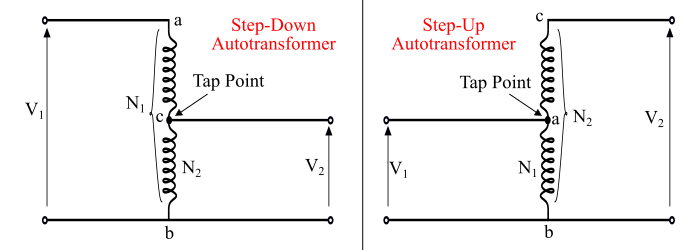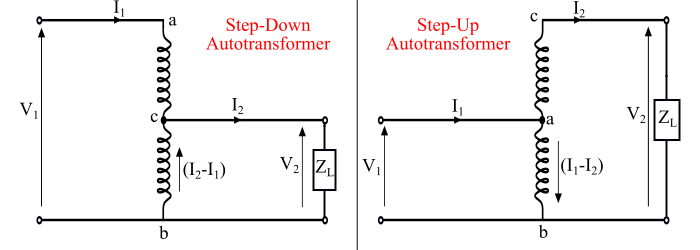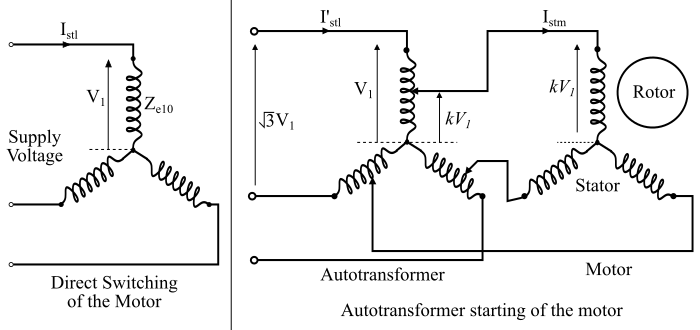
- Electrical Machines - Home
- Basic Concepts
- Electromechanical Energy Conversion
- Energy Stored in Magnetic Field
- Singly-Excited and Doubly Excited Systems
- Rotating Electrical Machines
- Electrical Machines Types
- Faraday’s Laws of Electromagnetic Induction
- Concept of Induced EMF
- Fleming's Left Hand and Right Hand Rules
- Transformers
- Electrical Transformer
- Construction of Transformer
- EMF Equation of Transformer
- Turns Ratio and Voltage Transformation Ratio
- Ideal Transformer
- Practical Transformer
- Ideal and Practical Transformers
- Transformer on DC
- Losses in a Transformer
- Efficiency of Transformer
- 3-Phase Transformer
- Types of Transformers
- More on Transformers
- Transformer Working Principle
- Single-Phase Transformer Working Principle
- 3-Phase Transformer Principle
- 3-Phase Induction Motor Torque-Slip
- 3-Phase Induction Motor Torque-Speed
- 3-Phase Transformer Harmonics
- Double-Star Connection (3-6 Phase)
- Double-delta Connection (3-6 Phase)
- Transformer Ratios
- Voltage Regulation
- Delta-Star Connection (3-Phase)
- Star-Delta Connection (3-Phase)
- Autotransformer Conversion
- Back-to-back Test (Sumpner's Test)
- Transformer Voltage Drop
- Autotransformer Output
- Open and Short Circuit Test
- 3-Phase Autotransformer
- Star-Star Connection
- 6-Phase Diametrical Connections
- Circuit Test (Three-Winding)
- Potential Transformer
- Transformers Parallel Operation
- Open Delta (V-V) Connection
- Autotransformer
- Current Transformer
- No-Load Current Wave
- Transformer Inrush Current
- Transformer Vector Groups
- 3 to 12-Phase Transformers
- Scott-T Transformer Connection
- Transformer kVA Rating
- Three-Winding Transformer
- Delta-Delta Connection Transformer
- Transformer DC Supply Issue
- Equivalent Circuit Transformer
- Simplified Equivalent Circuit of Transformer
- Transformer No-Load Condition
- Transformer Load Condition
- OTI WTI Transformer
- CVT Transformer
- Isolation vs Regular Transformer
- Dry vs Oil-Filled
- DC Machines
- Construction of DC Machines
- Types of DC Machines
- Working Principle of DC Generator
- EMF Equation of DC Generator
- Derivation of EMF Equation DC Generator
- Types of DC Generators
- Working Principle of DC Motor
- Back EMF in DC Motor
- Types of DC Motors
- Losses in DC Machines
- Applications of DC Machines
- More on DC Machines
- DC Generator
- DC Generator Armature Reaction
- DC Generator Commutator Action
- Stepper vs DC Motors
- DC Shunt Generators Critical Resistance
- DC Machines Commutation
- DC Motor Characteristics
- Synchronous Generator Working Principle
- DC Generator Characteristics
- DC Generator Demagnetizing & Cross-Magnetizing
- DC Motor Voltage & Power Equations
- DC Generator Efficiency
- Electric Breaking of DC Motors
- DC Motor Efficiency
- Four Quadrant Operation of DC Motors
- Open Circuit Characteristics of DC Generators
- Voltage Build-Up in Self-Excited DC Generators
- Types of Armature Winding in DC Machines
- Torque in DC Motors
- Swinburne’s Test of DC Machine
- Speed Control of DC Shunt Motor
- Speed Control of DC Series Motor
- DC Motor of Speed Regulation
- Hopkinson's Test
- Permanent Magnet DC Motor
- Permanent Magnet Stepper Motor
- DC Servo Motor Theory
- DC Series vs Shunt Motor
- BLDC Motor vs PMSM Motor
- Induction Motors
- Introduction to Induction Motor
- Single-Phase Induction Motor
- 3-Phase Induction Motor
- Construction of 3-Phase Induction Motor
- 3-Phase Induction Motor on Load
- Characteristics of 3-Phase Induction Motor
- Speed Regulation and Speed Control
- Methods of Starting 3-Phase Induction Motors
- More on Induction Motors
- 3-Phase Induction Motor Working Principle
- 3-Phase Induction Motor Rotor Parameters
- Double Cage Induction Motor Equivalent Circuit
- Induction Motor Equivalent Circuit Models
- Slip Ring vs Squirrel Cage Induction Motors
- Single-Cage vs Double-Cage Induction Motor
- Induction Motor Equivalent Circuits
- Induction Motor Crawling & Cogging
- Induction Motor Blocked Rotor Test
- Induction Motor Circle Diagram
- 3-Phase Induction Motors Applications
- 3-Phase Induction Motors Torque Ratios
- Induction Motors Power Flow Diagram & Losses
- Determining Induction Motor Efficiency
- Induction Motor Speed Control by Pole-Amplitude Modulation
- Induction Motor Inverted or Rotor Fed
- High Torque Cage Motors
- Double-Cage Induction Motor Torque-Slip Characteristics
- 3-Phase Induction Motors Starting Torque
- 3-phase Induction Motor - Rotor Resistance Starter
- 3-phase Induction Motor Running Torque
- 3-Phase Induction Motor - Rotating Magnetic Field
- Isolated Induction Generator
- Capacitor-Start Induction Motor
- Capacitor-Start Capacitor-Run Induction Motor
- Winding EMFs in 3-Phase Induction Motors
- Split-Phase Induction Motor
- Shaded Pole Induction Motor
- Repulsion-Start Induction-Run Motor
- Repulsion Induction Motor
- PSC Induction Motor
- Single-Phase Induction Motor Performance Analysis
- Linear Induction Motor
- Single-Phase Induction Motor Testing
- 3-Phase Induction Motor Fault Types
- Synchronous Machines
- Introduction to 3-Phase Synchronous Machines
- Construction of Synchronous Machine
- Working of 3-Phase Alternator
- Armature Reaction in Synchronous Machines
- Output Power of 3-Phase Alternator
- Losses and Efficiency of an Alternator
- Losses and Efficiency of 3-Phase Alternator
- Working of 3-Phase Synchronous Motor
- Equivalent Circuit and Power Factor of Synchronous Motor
- Power Developed by Synchronous Motor
- More on Synchronous Machines
- AC Motor Types
- Induction Generator (Asynchronous Generator)
- Synchronous Speed Slip of 3-Phase Induction Motor
- Armature Reaction in Alternator at Leading Power Factor
- Armature Reaction in Alternator at Lagging Power Factor
- Stationary Armature vs Rotating Field Alternator Advantages
- Synchronous Impedance Method for Voltage Regulation
- Saturated & Unsaturated Synchronous Reactance
- Synchronous Reactance & Impedance
- Significance of Short Circuit Ratio in Alternator
- Hunting Effect Alternator
- Hydrogen Cooling in Synchronous Generators
- Excitation System of Synchronous Machine
- Equivalent Circuit Phasor Diagram of Synchronous Generator
- EMF Equation of Synchronous Generator
- Cooling Methods for Synchronous Generators
- Assumptions in Synchronous Impedance Method
- Armature Reaction at Unity Power Factor
- Voltage Regulation of Alternator
- Synchronous Generator with Infinite Bus Operation
- Zero Power Factor of Synchronous Generator
- Short Circuit Ratio Calculation of Synchronous Machines
- Speed-Frequency Relationship in Alternator
- Pitch Factor in Alternator
- Max Reactive Power in Synchronous Generators
- Power Flow Equations for Synchronous Generator
- Potier Triangle for Voltage Regulation in Alternators
- Parallel Operation of Alternators
- Load Sharing in Parallel Alternators
- Slip Test on Synchronous Machine
- Constant Flux Linkage Theorem
- Blondel's Two Reaction Theory
- Synchronous Machine Oscillations
- Ampere Turn Method for Voltage Regulation
- Salient Pole Synchronous Machine Theory
- Synchronization by Synchroscope
- Synchronization by Synchronizing Lamp Method
- Sudden Short Circuit in 3-Phase Alternator
- Short Circuit Transient in Synchronous Machines
- Power-Angle of Salient Pole Machines
- Prime-Mover Governor Characteristics
- Power Input of Synchronous Generator
- Power Output of Synchronous Generator
- Power Developed by Salient Pole Motor
- Phasor Diagrams of Cylindrical Rotor Moto
- Synchronous Motor Excitation Voltage Determination
- Hunting Synchronous Motor
- Self-Starting Synchronous Motor
- Unidirectional Torque Production in Synchronous Motor
- Effect of Load Change on Synchronous Motor
- Field Excitation Effect on Synchronous Motor
- Output Power of Synchronous Motor
- Input Power of Synchronous Motor
- V Curves & Inverted V Curves of Synchronous Motor
- Torque in Synchronous Motor
- Construction of 3-Phase Synchronous Motor
- Synchronous Motor
- Synchronous Condenser
- Power Flow in Synchronous Motor
- Types of Faults in Alternator
- Miscellaneous Topics
- Electrical Generator
- Determining Electric Motor Load
- Solid State Motor Starters
- Characteristics of Single-Phase Motor
- Types of AC Generators
- Three-Point Starter
- Four-Point Starter
- Ward Leonard Speed Control Method
- Pole Changing Method
- Stator Voltage Control Method
- DOL Starter
- Star-Delta Starter
- Hysteresis Motor
- 2-Phase & 3-Phase AC Servo Motors
- Repulsion Motor
- Reluctance Motor
- Stepper Motor
- PCB Motor
- Single-Stack Variable Reluctance Stepper Motor
- Schrage Motor
- Hybrid Schrage Motor
- Multi-Stack Variable Reluctance Stepper Motor
- Universal Motor
- Step Angle in Stepper Motor
- Stepper Motor Torque-Pulse Rate Characteristics
- Distribution Factor
- Electrical Machines Basic Terms
- Synchronizing Torque Coefficient
- Synchronizing Power Coefficient
- Metadyne
- Motor Soft Starter
- CVT vs PT
- Metering CT vs Protection CT
- Stator and Rotor in Electrical Machines
- Electric Motor Winding
- Electric Motor
- Useful Resources
- Quick Guide
- Resources
- Discussion
Electrical Machines - Autotransformer
An autotransformer is a one winding transformer in which a part of the winding is common to both primary and secondary windings.
An autotransformer has a single continuous winding with a tap point between the primary and secondary windings. The tap point can be adjusted to obtain the desired output voltage, hence this is an obvious advantage of the autotransformer. The main disadvantage of an autotransformer is that the secondary winding is not electrically isolated from the primary.
Theory of Autotransformer
Case 1 - Autotransformer on No-Load
The connection diagram of an unloaded autotransformer (step-down and step-up) is shown in the figure. In this, the winding 'ab' is called primary winding having N1 turns and the winding 'bc' is called secondary winding having N2 turns.

Here it can be noted that the primary and secondary windings are connected magnetically as well as electrically. Thus, the power from the primary winding is transferred to the secondary winding magnetically as well as conductively.
Case 2 - Autotransformer on Load
When the load is connected to the secondary of an autotransformer, then it is said to be loaded. The figure shows the circuit diagram of a loaded autotransformer (step-down and step-up).

In which the current I1 is the primary input current and the current I2 is the secondary output current or load current. The current in common portion of the primary and secondary windings is the difference of the currents I1 and I2, regardless of whether the autotransformer is stepdown or step-up.
For the step-down autotransformer the current I2 > I1, thus the current flowing in the common portion is
$$\mathrm{\text{Current in common portion } \: = \: I_{2} \: - \: I_{1}}$$
For the step-up autotransformer the current I2 < I1, thus the current in the common portion is
$$\mathrm{\text{Current in common portion } \: = \: I_{1} \: - \: I_{2}}$$
Circuit and Working Principle of Autotransformer Starter
The circuit diagram of an autotransformer starter for starting a 3-phase induction motor is shown in the figure. The autotransformer starter can be used for starting both star and delta connected 3-phase induction motors. In this method, the starting current of the motor is limited by using a 3-phase autotransformer to decrease the initial applied voltage to the stator. The autotransformer is provided with a number of tappings to obtain the variable voltage.

In the autotransformer starting method, the starter is connected to a particular tapping of the autotransformer to obtain the most suitable starting voltage. A changeover switch S is used to connect the autotransformer in the circuit for starting the motor.
When the handle (H) of the switch S is at the START position, the primary winding of the autotransformer is connected to supply line and the induction motor is connected to the secondary winding of the autotransformer. When the motor picks up the speed (about 80 % of the rated speed), then the handle H is thrown to the RUN position. Consequently, the autotransformer is isolated from the circuit and the motor is now directly connected to the supply line and gets its rated voltage.
The handle is held in the RUN position by the under-voltage relay. When the supply voltage fails or falls below a certain value, then the handle is released and comes back to the OFF position. To provide the overload protection to the motor, a thermal overload relay is used in the motor circuit.
Theory of Autotransformer Starter
The figure below shows the circuit connections for the direct switching of the motor and the autotransformer starting of the motor.

When direct switching of the motor to the supply line −
Let,
Ze10 = Per phase equivalent impedance of motor referred to stator at standstill
V1 = Supply voltage per phase
Thus, when the full supply voltage per phase (V1) is applied to the motor with direct switching, then the starting line current drawn by the motor from the supply line is given by,
$$\mathrm{I_{stl} \:=\:\frac{V_{1}}{Z_{10}} \:\: \dotso \:(1)}$$
Now, with autotransformer starting, if a tapping of autotransformer with transformation ratio kis used, then the voltage available across the secondary winding terminals of the autotransformer (i.e., the voltage per phase across the motor) is kV1. Hence, the starting current of the motor with autotransformer starting is given by,
$$\mathrm{I_{stm} \:=\: \frac{kV_{1}}{Z_{e10}} \:\: \dotso \:(2)}$$
If the no-load current of the transformer is neglected, then, the ratio of currents in a transformer is inversely proportional to the voltage ratio, i.e.,
$$\mathrm{\frac{I_{1}}{I_{2}} \:=\: \frac{V_{2}}{V_{1}}}$$
$$\mathrm{\Rightarrow \: V_{1}I_{1} \:=\: V_{2}I_{2}}$$
Thus,
$$\mathrm{V_{1}{I^{′}_{stl}} \:=\: kV_{1}I_{stm}}$$
Where, ${I^{′}_{stl}}$ is the line current drawn from the supply by the autotransformer.
$$\mathrm{\Rightarrow I^{′}_{stl} \:=\: kI_{stm} \:\: \dotso \:(3)}$$
Substituting the value of Istm from eqn. (2) in eq. (3), we get,
$$\mathrm{ I^{′}_{stl} \:=\: k\left(\frac{kV_{1}}{Z_{e10}}\right) \:=\: \frac{k^{2}V_{1}}{Z_{e10}} \:\: \dotso \:(4)}$$
Therefore,
$$\mathrm{\frac{\text{Starting Current with Autotransformer Starter}\:(I′_{stl} )}{\text{Starting current with direct switching } \: (I_{stl})} \:=\: \frac{\frac{k^{2}V_{1}}{Z_{e10}}}{\frac{V_{1}}{Z_{e10}}} \:=\: k^{2}}$$
$$\mathrm{\therefore \: \text{ Starting Current with Autotransformer Starter } \:=\: k^{2} \: \times \: \text{ Starting Current with Direct Switching } \:\: \dotso \:(5)}$$
Since the torque developed in an induction motor is directly proportional to the square of the applied voltage. Thus, the torque with direct switching of the motor is,
$$\mathrm{\tau_{std} \: \propto \: V_{1}^{2} \:\: \dotso \:(6)}$$
And, the torque developed with the autotransformer starter is,
$$\mathrm{\tau_{sta} \: \propto \: k^{2} V_{1}^{2} \:\: \dotso \:(7)}$$
Hence,
$$\mathrm{\frac{\text{Starting Torque with Autotransformer Starter } \: (\tau_{sta})}{\text{Starting Torque with Direct Switching } \: (I_{std})} \:=\: \frac{k^{2}V_{1}^{2}}{V_{1}^{2}} \:=\: k^{2}}$$
$$\mathrm{\therefore \: \text{ Starting Torque with Autotransformer Starter } \:=\: k^{2} \: \times \: \text{ Starting Torque with Direct Switching} \:\: \dotso \:(8)}$$
From the eqns. (5) and (8), it is clear that with an autotransformer starter, the starting current of the motor drawn from the main supply line and the starting torque are reduced to k2 times of their corresponding values with the direct switching starting of the motor.
Advantages of Autotransformer
The advantages of an autotransformer are given as follows −
- An autotransformer has smaller core and copper losses and hence higher efficiency as compared to an ordinary 2-winding transformer.
- Autotransformer requires less conductor material as compared to the 2-winding transformer.
- It has better voltage regulation due to reduced voltage drops in resistance and leakage reactance.
- It has smaller size and cheaper than a 2-winding transformer.
- It requires smaller excitation current.
- An autotransformer can produce variable output voltage.
Disadvantages of Autotransformer
The disadvantages of an autotransformer are given as follows −
- There is a direct connection between the primary and secondary sides. In case of an open circuit in the common portion bc of the windings, the full primary voltage would be applied to the load on the secondary side. This may damage the equipment connected to the secondary side.
- An autotransformer has reduced internal impedance as compared to a 2-winding transformer which results in a larger short circuit current.
- The autotransformer is not electrically isolated, thus cannot be used to isolate two circuits electrically.
Applications of Autotransformer
The autotransformer is mainly used in following applications −
- The autotransformers are used for boosting of supply voltage to compensate the voltage drops in distribution systems.
- Autotransformers are used for interconnection of power systems of different voltage levels.
- The autotransformers with tapings are used for starting induction motors and synchronous motors.
- The autotransformers are used as variac (variable AC) in the situations where a continuous variable voltage over a wide range is required.